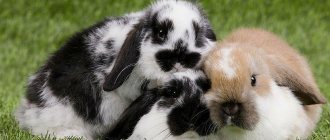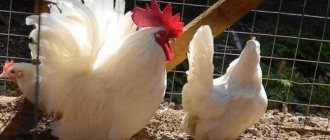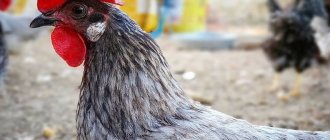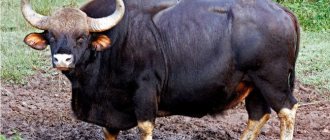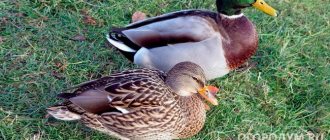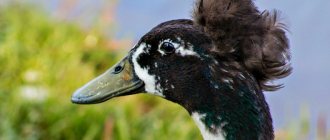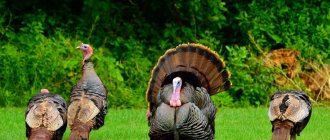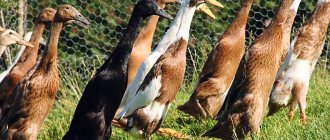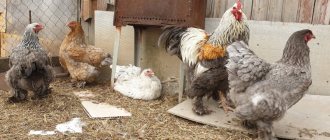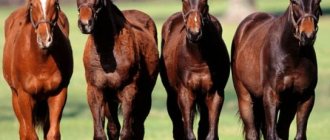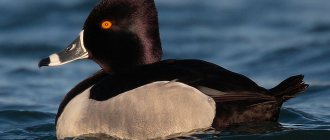Home » Articles about ducks » Favorite duck: description of the breed
The favorite duck is a cross bred over 20 years ago. In accordance with the description, the bird has good productivity, it is unpretentious, ducklings in the second generation retain their parental characteristics and only later the characteristics split.
Duck favorite: description of the breed, breeding, rearing and characteristics of the breed (100 photos and videos)
Blue favorite ducks are an excellent option for those who breed this bird for meat.
They have a beautiful blue color and a white spot on the chest. This breed is a cross bred on the basis of the well-known Peking ducks. The weight of ducks of this breed can reach 5 kg. Therefore, the blue favorite cross is considered quite successful. Most often, only the first generation is used for cultivation. Since when crossing individuals of the first generation, the best qualities of the breed will not be preserved in the second.
What is the description and characteristics of Blue Favorite ducks?
Description of the breed
The favorite is large ducks, they quickly gain weight. The feet of these ducks are strong, which is good for carrying heavy body weight. In most cases, raising these ducks is only suitable for meat production. Due to the blue color of the plumage, the color of the birds' beak and paws is blue-green.
There is also another color of the favorite breed - red. They differ from blue ones only in color. This is clearly visible in the photo of the favorite ducks.
It is best to purchase ready-made ducklings or hatching eggs from poultry farms or factories. This way you can get blue favorite ducks that are ideal for breeding at home.
When breeding, the bird may exhibit different plumage colors and lower body weight. Another disadvantage of independent breeding can be considered the high mortality of offspring and the death of embryos.
How to distinguish a duck from a drake
In any case, at an early age there is no way to distinguish a drake from a favorite duck, and even when they grow up, their color is almost no different from each other. In order to understand where each individual is, it is necessary to wait for the first molt.
However, this should only be done if you intend to raise ducks and not raise them for meat. They quickly gain weight, and after molting, they gain fat.
But there is another way to determine the sex of ducks. It is enough to catch an individual and listen to its voice. Ducks have a loud quack, and drakes make sounds that resemble hissing.
Another feature of the breed is that when killed late, many feather tails remain. To avoid such an unpleasant effect, ducks begin to be slaughtered at the age of 3 months. At this point, the weight of the favorite duck is 3-4 kg.
Incubation of eggs
Blue Favorite ducks are not able to hatch eggs on their own, so if you want to hatch the chicks yourself, you need to incubate them.
It is advisable to collect eggs as often as possible, because they must be clean before loading into the incubator. But washing them is not recommended. The remaining rules for incubating eggs are exactly the same as for other breeds of ducks.
Ducklings of this breed are well resistant to various diseases. After hatching, the ducklings must be sent to a wooden or cardboard box. It is imperative to prepare food and water for the chicks, as well as constant light and warmth.
Duck house favorite
Many poultry farmers raise favorite ducks only in warm weather. This is due to the rapid weight gain of this breed and the early slaughter of the favorite duck. Therefore, there is an opinion that an ordinary enclosure fenced with a net is sufficient for them. But, for complete comfort, you should still build a small wooden shed for them.
Almost all ducks are waterfowl, so houses for them are often built near a pond. The truth is that not every poultry farmer has even a small pond on his property or nearby.
In such cases, you can build your own small pond in the duck pen. Simply dig a hole, waterproof it, and then fill it with water. An ordinary deep trough will also work well.
What to feed your favorites
Favorite ducks are characterized by rapid weight gain. Not enough feed leads to less meat, and too much feed leads to more fat.
A good half of farmers claim that it is better not to feed the poultry, resulting in delicious, tender meat weighing less than half a kilogram, or at most a kilogram. And fat spoils not only the taste, but also affects the egg production of the duck.
Moreover, with low weight, their meat becomes even more dietary than that from musky ducks. But for commercial purposes, the weight of the carcass is still considered the most important.
Breeding: choice of producers
If desired, the birds can also be used as a parent flock. Self-breeding favorite ducks is a rather complicated procedure. But you can still get ducklings of this breed (not multi-colored, but with blue plumage and good productivity indicators) on your farm.
To do this, you need to take a responsible approach to choosing manufacturers. You can get good young animals only from ducks and drakes with blue, as dark as possible feather color. Cream or pale blue individuals produce very light-colored ducklings (white-breasted or simply Peking ducklings).
Origin and distribution
The steppe spaces of Europe and the deserts of Africa are considered the homeland of birds. Ducks were also found in small numbers in Central Asia. The Asian bird population is in constant migration, reaching China, India and Taiwan.
In Russia, ducks are found everywhere today. The bird appeared in Moscow in the 20s of the 20th century, when the first individuals were brought to the zoo. They multiplied quickly and soon occupied the reservoirs of park areas.
Due to their very attractive appearance, birds have become a natural decoration for ponds and lakes.
Not too shy, they have adapted well to city conditions and feel very comfortable.
Description and productivity characteristics of Favorit cross ducks, their breeding
Amateur poultry farmers keep on their farms not only common breeds of ducks, but also productive crosses that have interesting qualities.
Duck Favorite is one of these interbreed crosses, which is suitable not only for industrial, but also for home breeding.
Let's take a closer look at its description and productivity characteristics, as well as the features of cultivation in private poultry houses.
Origin
This cross was obtained in Bashkiria at the Duet LLC duck farm in 1998. The main breed with which the work was carried out was Peking.
Individuals that were selected for certain qualities were crossed with representatives of the Bashkir and black white-breasted breeds.
The goal of the breeding work was to create early-maturing ducks with large body weight, decent egg production and a calm character. Favorite ducks meet all these characteristics.
The new meat and egg cross was named Favorite. Most of the ducks currently bred (since 2005) are located in the Blagovarsky breeding farm, which is their main producer. A certain number of livestock are kept by amateur poultry farmers.
Description of ducks
The exterior of Favorites is typical for ducks of meat breeds:
- large, long and wide body;
- the body is located almost horizontally;
- moderately pronounced breasts;
- medium length neck;
- large head with a long and flat beak of a dark gray-blue or dirty yellow color;
- powerful short legs of the same color;
- thick fluff used in industry.
According to the Blagovarsky PPZ description, blue Favorite ducks have ash-gray plumage all over the body and a white breast.
But this color is unstable, if you breed representatives of the cross by crossing them with each other, in the 2nd generation individuals will appear not only blue, but also lighter or darker than the typical color, as well as black (at least a quarter of the total number), white, brown, fawn and even intermediate options between these colors. At the same time, productivity often decreases.
Productivity characteristics
Since this cross is large, birds at 2 months of age can already weigh 3.7 kg for drakes and 3.5 kg for ducks. At this age they are ready for slaughter.
If they grow up to 3-4 months, then males can already weigh 4.5-5 kg, and females, respectively, 4 kg. With intensive feeding at 6 months, adult drakes can gain 6-7 kg.
The meat has high taste characteristics, fat content is up to 37%.
The favorites can also boast of good egg production rates - from one laying duck in 40 weeks of productivity you can get 230 eggs with an average weight of 90 g. Females begin laying eggs at 6 months.
Advantages and disadvantages
Favorites would not be bred in industrial poultry houses if they did not have certain advantages, namely:
- precocity;
- large body, and therefore a large carcass;
- good quality meat;
- calm character (almost no noise);
- good egg production.
Disadvantages: lack of brooding instinct and the fact that representatives of the cross or eggs for incubation are quite difficult to obtain.
Breeding at home
Since this is a cross and not a breed, it is advisable to purchase ducks for breeding at home from specialized poultry farms.
If you want to reproduce them yourself, then you need to take into account the fact that when crossing 2 blue ducks, the brightening gene that is in their genotype negatively affects not only the fertilization of the eggs, but also the course of the embryonic development of the duckling inside them. It is noted that it leads to the death of up to 1/4 of all embryos.
Favorite ducks lack the brooding instinct, so an incubator will be needed to hatch ducklings. An egg collected from ducks older than 7 months is placed in it. The best ones are selected, no smaller than the standard size, without damage, fresh (no more than a week from the date of demolition). The incubation technology is the same as that of other duck breeds. Favorit cross ducklings are hatched on the 28th day.
To distinguish a duck from a drake, you will need to wait until the Favorites molt, after which the male will have feathers curved up near his tail, the female will not have them.
Features of care
Favorite ducks need to be kept in a good, solid barn. It should be spacious, for each grown individual there should be at least 0.5 square meters. m area. Although, allegedly, these ducks are not afraid of dampness and they can even put water for bathing directly in the nesting box, it is better not to do this, but to organize a paddock next to it, into which to drive the ducks.
In the summer you can keep them out for a walk constantly, driving them into the barn only in bad weather. It is advisable to insulate the duckling house for the winter, despite the fact that these ducks tolerate the cold well. Favorites are calm, so they can be kept with other duck breeds and chickens.
History of appearance
This new type of duck appeared in the Bashkir Autonomous Soviet Socialist Republic at the end of the last century. Breeders who worked at a breeding plant where new species of birds were bred (“Blagovarsky”) took the white Peking duck breed as a basis. It was crossed for a long time, the best chicks were selected, and as a result, the blue favorite was obtained almost in the form in which it currently exists.
This type of poultry was originally bred as "industrial". But when these ducks arrived on farms, and then on private farmsteads, the owners appreciated their excellent characteristics - fast meat production, good egg production. Therefore, the blue favorite is now becoming a popular poultry, the breeding of which has been taken seriously.
Blue ducks favorite for a walk
Representatives of this breed are large individuals with lovely bluish feathers with a smoky tint. The color of the plumage of females and males can vary from light to dark blue. This coloring is not considered a defect of nature, but occurs at the genetic level in birds of this breed.
Feeding
Ducks are as unpretentious in nutrition as they are in care. You can feed birds both grain feed and cheaper feed. Free daily walking and access to a pond gives the bird the opportunity to independently obtain its own greens.
If ducks are raised for slaughter, you can speed up weight gain by adding mash to the menu. Vegetable waste also contributes to weight gain. Ducks eat boiled potatoes well - with the skin on, pumpkin or zucchini.
Advice. If ducks do not have the ability to graze grass on their own, the task of providing the bird with greenery falls on the owner’s shoulders. You can add nettles and clover to the food.
There is no need to establish any strict diet. Ducks are not prone to eating disorders
There are no contraindications, but it is important to carefully check all vegetables for freshness. The same applies to prepared feeds.
Products of poor quality can cause poisoning and, as a result, slower weight gain or even weight loss.
Eggs, cottage cheese and milk are recommended for ducklings. Grain feed is introduced into the diet of chicks gradually, starting at one month of age.
Caring for little ducklings
Above, a description of the favorite duck (adult) was given, and methods of caring for it were discussed. Raising small chicks of this breed is also not difficult. Immediately after hatching, the ducklings should be allowed to dry a little in the incubator. Then they need to be placed in an insulated box or brooder.
On the first day, the optimal air temperature for little pharaohs is 32°C. Subsequently, this figure should be gradually reduced. Two-week-old ducklings can be kept without heating. But only if the room temperature drops below 18°C.
The light in the box with ducklings should be on around the clock for the first five days. By 10 days of age, daylight hours can be gradually shortened to 16 hours. The young are fed either with special ready-made formulas for small ducklings or with finely chopped boiled eggs and cottage cheese diluted with milk. In the first days, the chicks are fed at least 5-6 times a day.
Greens can be introduced into the diet almost immediately. On the 10th day, you can give the kids crushed food. In the second week, cottage cheese and eggs are abolished. Instead, boiled potatoes and carrots are introduced into the diet.
Key Content Features
The blue Favorite is not picky about living conditions and diet. Both hot and cold regions are well suited for breeding. Also, any non-insulated barn, room or even pen is perfect for breeding. But it is advisable to have a small body of water on or near the site. The survival rate of this breed is simply amazing, while its productive characteristics hardly suffer.
Any food is also suitable for them. Ducklings, like other birds, are fed boiled eggs after hatching. Then, when the ducklings are several days old, they are gradually transferred to other food. To a greater extent, these are different nutritional mash. In a word, everything that young animals need and nothing extra. You can include various succulent foods in the mash, for example, potatoes, zucchini, grass, etc.
Until the age of two months, ducklings should eat heavily. After two months, the diet becomes less abundant so that they gain weight more smoothly. Thus, by the age of four months, the blue Favorite has excellent meat characteristics and very little fat, which cannot be said when breeding most meat breeds. Also, unlike other ducks, the meat does not have a specific smell or taste and is considered healthier than chicken.
What else should you consider when planning your diet?
So, the farmer must decide on the amount of food for the favorites himself, depending on what he wants to get in the end. But the owner of a personal plot, of course, also needs to know what to feed the favorite ducks. A feature of this cross, like almost any other duck, is a fairly intense metabolism. And the intestines of this bird are somewhat shorter than, for example, those of the same chickens. Therefore, pharaohs willingly consume various types of bulky wet food. This could be, for example, finely chopped greens, chopped root vegetables or silage.
Ducks must also receive protein of animal origin. This could be, for example, small waste fish, meat and bone meal, etc. It is advisable to increase the volume of animal feed in the diet of the pharaohs to 10%. But if favorite ducks are kept only in the summer - for slaughter, and not for producing young animals, this figure can be reduced slightly.
Ducks should also receive concentrates. In this case, the bird can be given both whole grain and crushed grain.
Depending on the chosen feeding scheme, in the summer ducks of the favorite breed are fed two to three times a day. Usually in the morning and at lunch they give green mash with root vegetables and flour, and in the evening they offer grains. In winter, it is advisable to feed favorites at least 3 times a day. You can, of course, replace homemade food with special feed for ducks of combined productivity.
Diseases inherent in the breed
In birds, just like in humans, the immune system matures with age, so young ducks are more susceptible to illness than adults. Cross-favorite is distinguished by low susceptibility to various kinds of diseases, however, these ducklings can also get sick, especially in the first day of life.
Preliminary preparation of the poultry house, including thorough washing and disinfection of the room, greatly helps prevent the chicks from becoming ill.
It is important to avoid excessive crowding. Provided that the chicks will be indoors only for the first time with subsequent transfer, the density of heads should not exceed 16 heads per square meter
If ducklings have to live in the same room from the very first day until slaughter, the stocking density should be halved.
One of the keys to successfully raising healthy ducklings is the availability of clean water. Ducks, being waterfowl, are delighted to bathe in any container, so drinking bowls should be installed so that the chicks cannot climb there with the intention of taking a bath. An excellent solution would be to turn the jar upside down in a saucer. From about two weeks of age, ducklings can be given a special shallow bathing container.
Diseases of ducks can be divided into infectious and non-infectious. The following diseases are classified as non-infectious.
- Avitaminosis. The most common deficiency is vitamins A, E and D. With vitamin A deficiency, loss of appetite, conjunctivitis, and fluid discharge from the nasal passages are observed, but similar symptoms may be characteristic of a number of other infectious diseases. When the diagnosis of vitamin A deficiency is confirmed, sick individuals are fed with fish oil or synthetic vitamin supplements, and as a preventive measure, feed for young animals is enriched with fresh or dried herbs. With vitamin E deficiency, birds experience convulsions, lethargy, a weak pulse against the background of a complete lack of appetite. With a lack of vitamin D, rickets may develop.
- Level disease. Like vitamin deficiency, it can occur due to the paucity of the diet for all kinds of microelements and minerals. When there is a shortage of them, the chicks pluck out their down and feathers, eat sawdust, earth and sand. For treatment and prevention, bone meal, iodized salt, crushed chalk and shells are used.
- Cuticulitis. Disease in ducklings in the first month of life. Against the background of apathy and lack of interest in food, the chicks experience dark-colored diarrhea with undigested pieces of food. For treatment, ducklings are given a light pink solution of ordinary potassium permanganate.
- Omphalitis. Inflammation of the umbilical ring of a non-infectious nature. Weak disinfectant solutions are used as treatment.
Infectious diseases.
- Coccidiosis. Ducks under one and a half months old most often suffer. Sick individuals lose their appetite, becoming slow and apathetic. The stool is usually liquid, brown in color, interspersed with blood and mucus. Sick individuals should be destroyed and isolated from the general flock.
- Tuberculosis. Koch's wand does not spare anyone, including ducks. Most often, the cause of tuberculosis is excessive crowding, dirt and stuffiness in the room in the absence of a normal ventilation system. If tuberculosis is confirmed, sick ducks are slaughtered, and antiseptic treatment measures are carried out in the poultry house.
- Hymenolepidosis. Damage to the intestinal tract by helminths. Treat with anthelmintics. Symptoms of the disease include stool disorders from constipation to diarrhea, convulsions, paralysis, and damage to the nervous system.
- Salmonellosis. An acute form of intestinal infection caused by pathogenic microorganisms of the Salmonella genus is equally dangerous for both birds and humans. Treatment requires isolation of sick individuals for the purpose of feeding them with antibacterial drugs, for example, tetracycline.
In addition to the listed diseases, ducklings can become infected with typhoid or cholera. When sick with typhus or cholera, no treatment is carried out - the sick bird is destroyed, the carcasses are burned, healthy birds are quarantined for the entire duration of the incubation period.
advantages and disadvantages of the breed
Productive qualities: which bird to choose
When raising ducks for meat, preference is often given to mulards, since these birds have a number of advantages:
- a large mass that an individual gains in a short period of time. Poultry farmers note that mulards fatten faster than geese and other domestic ducks;
- tender meat with low fat content;
- large liver in males is a delicacy, used for foie gras.
It should be taken into account that breeding mulards at home naturally is impossible, and the cost of the hybrid is higher than other meat-producing ducks.
Which bird do you prefer for breeding and raising at home?
MulardamIndoutkam
Indo-ducks, on the contrary, can be bred independently; they do not require special housing conditions and can do without a pond. This species is characterized by high survival rate and unpretentiousness in food. In addition to meat, you can also use turkey eggs for food, the beneficial properties of which are not inferior to chicken eggs. These advantages, combined with the high proportion of useful substances contained in the products, make musk ducks not only attractive to poultry farmers, but also more in demand than mulards.
Video
If you are interested in the topic of the article, we suggest watching several videos in which experienced poultry farmers share tips on keeping Favorite ducks:
About the author:
Found a mistake? Select the text with the mouse and click:
Ctrl + Enter
Do you know that:
It is believed that some vegetables and fruits (cucumbers, stem celery, all varieties of cabbage, peppers, apples) have “negative calorie content,” that is, more calories are consumed during digestion than they contain. In fact, only 10-20% of the calories received from food are consumed in the digestive process.
Diseases
In general, all breeders agree that this is a very healthy breed. Ducks have a good immune system and low susceptibility to disease. Another advantage is that almost all the young from the brood survive. The first days of life of chicks are considered critical.
What diseases are especially dangerous for this breed?
Ducklings are most often at risk of illnesses such as:
- Cuticulitis. This is a disease of the first month of life. These chicks have poor appetite and diarrhea.
- Level disease. Occurs due to poor diet. During it, ducklings pluck their feathers and begin to eat sand and sawdust.
- Avitaminosis. A lack of vitamins threatens weakness, rickets, and loss of appetite.
Dangerous diseases for adults are:
- tuberculosis (most often occurs if ducks live crowded in a dirty poultry house);
- intestinal infections (especially salmonellosis).
Disease Prevention
Avoiding diseases is quite simple. Need to:
- Keep the poultry house clean.
- Keep no more than 8 ducks per 1 square meter.
- Change water in drinking bowls daily.
- The chicks should be highlighted and given balanced food.
By following these simple rules, you can be sure that your flock of ducks will be healthy.
In general, as noted above, this is a very unpretentious breed that quickly gains weight and produces hundreds of eggs per year. Blue ducks can be raised both at home and on large farms.
Description of the breed
Ducks of the Blue Favorite breed were bred by chance during the improvement of Peking and Bashkir birds. They have gained popularity not only because of their meat qualities, but also because of the beautiful color of their plumage.
Description and characteristics of the appearance of birds are as follows:
- the head is medium-sized, closer to large;
- the beak is elongated, wide and flat;
- eyes are small;
- neck of medium length;
- the body is powerful, with developed muscles, elongated in length;
- the breast is wide and deep;
- extended back;
- legs are short and thick.
The plumage color of these ducks is gray with a magnificent blue tint. There are both more saturated and lighter blue shades. There is also a description that black, dark gray and almost white birds can be found in the lines. The color of the beak and paws depends on the color of the feather. In true blue ducks they are dark, gray in color.
It is important to know that blue-gray birds can produce offspring of any color, while black birds can only produce black ones. It is difficult to predict what color chicks will appear in white birds.
When you buy a hatching egg or a duck, even the perfect blue color, it is impossible to predict what kind of heritage will emerge from her ducklings.
You can see in more detail what the Blue Favorite looks like in the photo and video.
Optimal planting density
The growth of young ducklings depends on how they feed and receive warmth. Because they are bored, they begin to push each other aside and put pressure on each other. And therefore the growth of ducklings stops.
For proper growth, weak and frail representatives need to be planted separately. Sorting your ducklings at least once a week will help produce bigger, healthier ducks. Babies mainly appear as a result of their mass rearing. They don't have enough food. Be that as it may, one part of the ducklings will lag behind in their development, since not all of them pay attention to feeding. As a result of all this, animals grow small and weak. In order for such ducklings to develop well, you need to feed them with a pipette at first. Make a mixture of egg yolk and warm milk.
How to keep ducks?
The breed is hardy. Birds are not afraid of sudden cold snaps and frosts; they have an excellent immune system. And although they do not require ideal conditions, the minimum is necessary for the normal functioning of these birds. What is needed to maintain them?
Bird house for Blue minion
The poultry house or pen must have a good roof to prevent rain, snow, and hail from getting inside. Insulation of walls or floors is not required, but it is worth providing additional lighting
Birds need at least 16 hours of daylight. During the day, large windows are suitable for lighting, and lamps are installed for the evening and night. A brooder or a separate room is made for ducklings so that adults do not interfere with their growth and development.
The paddock is created without fail
The blue favorite will not live locked up. If possible, it is recommended to take the birds to a pond. Swimming improves the condition of feathers and down, the health of birds, and also saves money on food, since in reservoirs they can find a lot of useful algae and duckweed.
They are resistant to diseases, but vaccination will not harm. It is important to immediately take the duck to the veterinarian at the first dangerous signs of disease (or simply call a veterinarian at home), since some duck diseases can destroy the entire bird population. Cleaning and disinfection are carried out regularly. This applies to walls, drinking bowls, feeders, cages (if any), fences, floors, nests, perches and everything else. Birds should not live in a dirty environment as they may become sickly and their productivity will be impaired.
Duck Blue Favorite: description of the breed, photo, breeding at home
When choosing a breed or cross of waterfowl for meat production, the poultry farmer pays attention not only to growth rate, final carcass weight and good health, but also to attractive appearance. Hybrid duck Blue Favorite meets high requirements on all counts
How to distinguish a duck from a drake
In representatives of the cross, sexual dimorphism (a clear difference in appearance between females and males) is not expressed; it is not easy to isolate males from the population. Drakes are only slightly (no more than 400 g) heavier than females, they have a wider forehead and a more powerful beak.
It is necessary to focus not on the appearance, but on the behavior of the bird:
- Blue Favorite ducks are calmer than drakes;
- males make shrill sounds at high notes, ducks quack more quietly.
Experienced poultry farmers determine the sex of a bird by the condition of the cloaca
To do this, place the duck on its back and carefully move the skin around the anus to the side, lightly pressing the belly with your fingers. Females will have two spherical tubercles visible, while the drake will have a rudimentary penis.
When they start rushing
Blue Favorite ducks begin laying eggs at the age of 7–8 months. The timing of the start of egg laying is influenced by environmental conditions: air temperature, lighting and feeding. To obtain duck eggs in winter and early spring, laying hens are kept in warm poultry houses with additional lighting. Vitamins and mineral supplements must be added to the feed.
Features of keeping Blue minions
In order for broiler birds to show their characteristic growth rates, it is necessary to take a responsible approach to feeding the livestock.
For ducks, insulated rooms without drafts are prepared for the winter. Water should not freeze in the barn; the optimal temperature is 10–12 degrees. A thick layer of straw or wood shavings is used as bedding.
Small sawdust should not be used; the bird may swallow it and die.
In summer, it is recommended to keep the livestock on range by constructing a mobile pen and a light canopy where the bird can hide from the sun and rain. Having a pond for blue ducks is desirable, but not required.
Possible diseases
In general, Blue Favorites have strong immunity. But, like any living organism, they are defenseless against parasites, viruses and bacteria: salmonellosis, typhoid, pasteurellosis, eimeriosis. The infection can enter the farm with purchased individuals or with wild birds and animals. You can protect your livestock from infection by following sanitary requirements:
- 30-day quarantine for new birds;
- feeding a new batch of ducklings with feed antibiotics;
- protection of the farm from the penetration of wild animals and birds.
If the maintenance rules are not followed and the diet is incorrect, the livestock may suffer from vitamin deficiency, external and internal parasites. When feeding spoiled food, poisoning can occur.
Advantages and disadvantages
Poultry farmers call the main advantages of raising Favorite ducks:
- rapid growth of young animals;
- unpretentiousness;
- high egg production for ducks;
- delicious tender meat.
The disadvantages of the cross are considered to be thermophilicity, lack of brooding instinct and poor inheritance of the productive traits of the parents by the offspring. To obtain purebred livestock, you need to purchase young animals or eggs from breeding farms. In the latter case, the role of the hen is performed by the incubator.
Farmers speak positively about Blue Favorite ducks. This is a good option for obtaining meat on a small farm. Quite high egg production, unpretentiousness and rapid growth make growing Favorites a profitable business.

